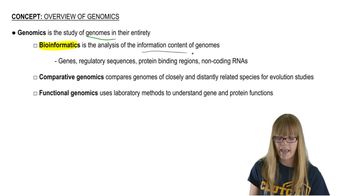15. Genomes and Genomics
Overview of Genomics
Practice this topic
- Multiple Choice
Genomics is the study of what?
- Multiple Choice
Which of the following is not a class of genomics?
- Open Question
In this chapter, we focused on the analysis of genomes, transcriptomes, and proteomes and considered important applications and findings from these endeavors. At the same time, we found many opportunities to consider the methods and reasoning by which much of this information was acquired. From the explanations given in the chapter, what answers would you propose to the following fundamental questions?
How has the concept of a reference genome evolved to encompass a broader understanding of genomic variation in humans? - Open Question
In this chapter, we focused on the analysis of genomes, transcriptomes, and proteomes and considered important applications and findings from these endeavors. At the same time, we found many opportunities to consider the methods and reasoning by which much of this information was acquired. From the explanations given in the chapter, what answers would you propose to the following fundamental questions?
What evidence supports the concept that humans share substantial sequence similarities and gene functional similarities with model organisms? - Open Question
In this chapter, we focused on the analysis of genomes, transcriptomes, and proteomes and considered important applications and findings from these endeavors. At the same time, we found many opportunities to consider the methods and reasoning by which much of this information was acquired. From the explanations given in the chapter, what answers would you propose to the following fundamental questions?
How do we know if a genomic DNA sequence contains a protein-coding gene? - Open Question
Write a short essay that explains how recombinant DNA techniques were used to identify and study genes compared to how modern genomic techniques have revolutionized the cloning and analysis of genes.

